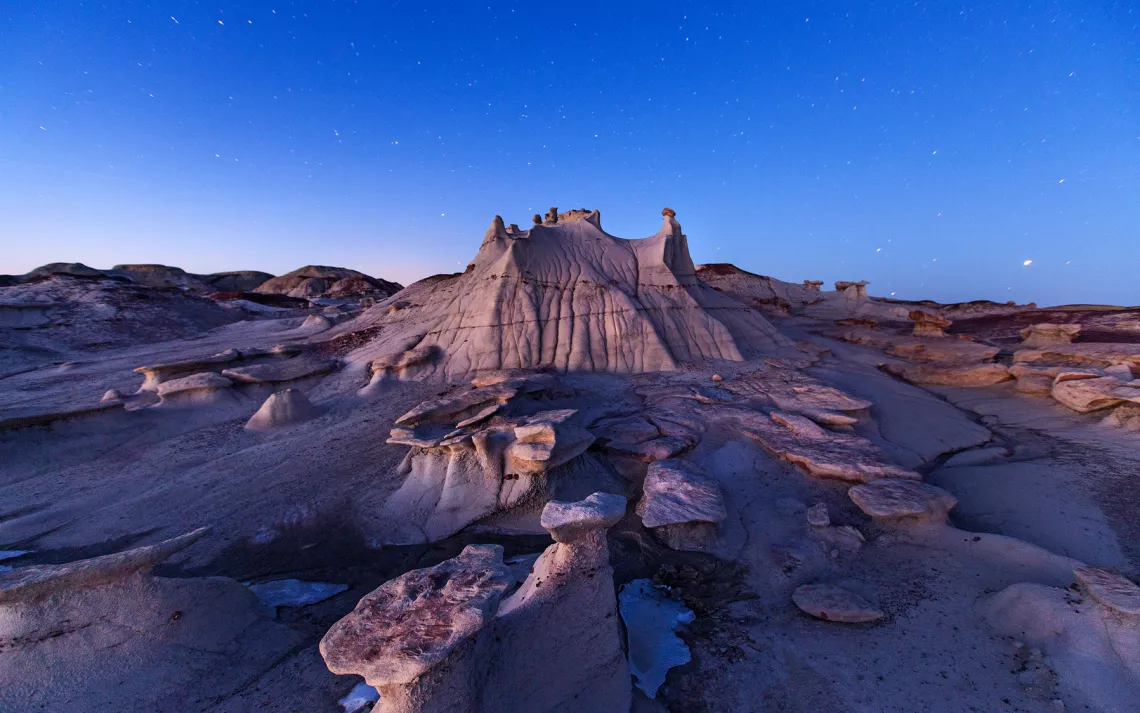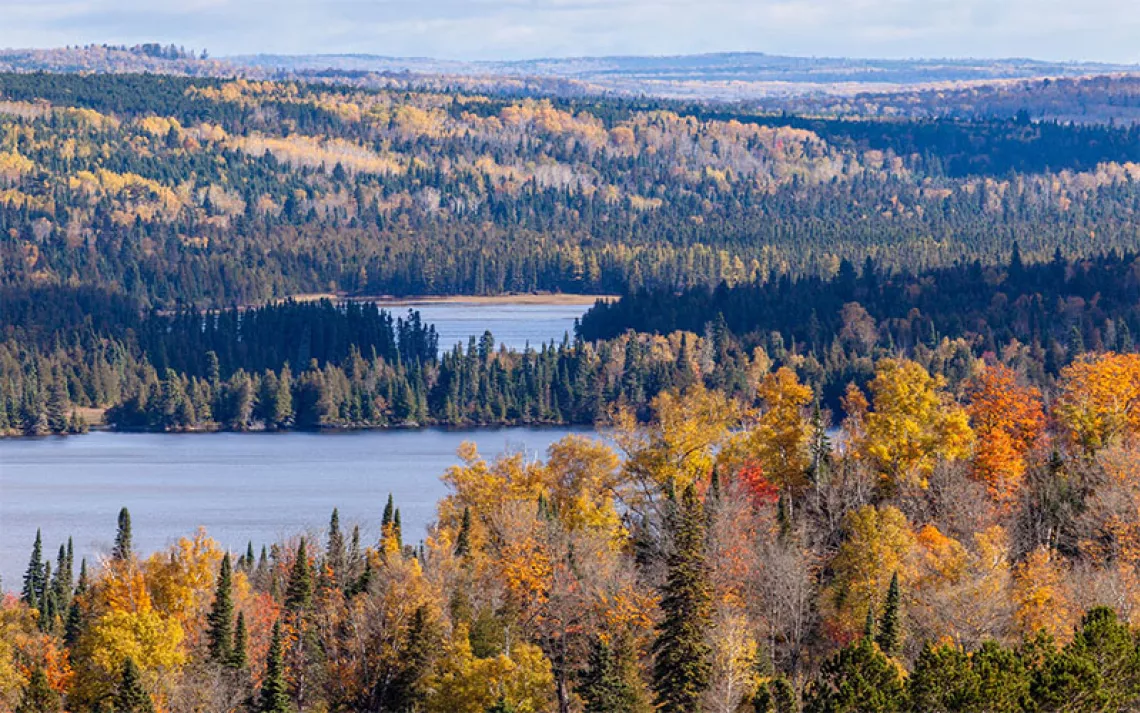Reclaiming Wilderness
It tells us who we are, and we lose it at our peril

Bisti/De-Na-Zin Wilderness Area, New Mexico | Photo by Ian Shive
When Dave Foreman heard that I was going to speak at the biennial Geography of Hope conference last year in Marin County, California, he made a request: "Try to get wolves and wilderness in." Foreman, the cofounder of Earth First! and a leader of the rewilding movement, is one of the two most riveting environmental evangelists I've ever heard preach; he ends his talks by howling like a wolf. The howling I can interpret, but his request puzzled me a bit. The conference was billed as three days dedicated to the ideas of Aldo Leopold. How could you celebrate Leopold without wolves and wilderness?
At the conference, I found out. In session after session, before an audience at Toby's Feed Barn in Point Reyes Station, speaker after speaker had nothing to say about either the wolf or the place it lives. Leopold's "land ethic" and his ideas on sustainability and restoration drew all the attention. The great forester's campaign leading to the 1924 designation of New Mexico's Gila Wilderness, the first anywhere, and his seminal writing on wildness in A Sand County Almanac went missing. When wilderness finally did come up, it was by way of dismissal. Wilderness is an antiquated notion, one panelist said. We have a new paradigm, said another. J. Baird Callicott, one of academia's leading wilderness deniers--or "wilderness deconstructionists," as Foreman calls this breed--told us that wilderness is a flawed idea and an imperialistic enterprise. If Leopold were alive and here today, Callicott said, he would have very different ideas on wilderness.
Yes, and Jefferson, if only we could fetch him, would disown his Declaration of Independence, and Lincoln his Emancipation Proclamation. For years I had laughed off this kind of revisionism, but now, at a Leopold symposium in Marin County, one of the greenest spots in the nation, I realized that we are losing the wilderness idea.
"Geography of hope," the title of the conference series, is the final phrase of the famous "Wilderness Letter" by Wallace Stegner. "We simply need that wild country available to us," Stegner concluded, "even if we never do more than drive to its edge and look in. For it can be a means of reassuring ourselves of our sanity as creatures, a part of the geography of hope."
Stegner sent that letter to David Brower, my father, the first executive director of the Sierra Club and the other most riveting environmental evangelist I've ever heard speak. At the time, 1960, my old man was near midpoint in his 10-year campaign to pass a wilderness bill. As editor of this magazine, then called the Sierra Club Bulletin, he regularly bombarded readers with propaganda for the legislation. In summertime, as leader of the Sierra Club High Trips, he introduced his four kids to the wilderness of the West, and in spring he dragged us around to the biennial Sierra Club Wilderness Conferences, which he had retooled as combination think tanks and tent revivals for the wilderness bill. In the off-season, at the family table, he indoctrinated us in wilderness theory and recited from wilderness thinkers and poets. Recognizing Stegner's letter as the finest expression yet of the wilderness idea, he published it in a Sierra Club book, Wilderness: America's Living Heritage, and from there it spread around the world.
When it came time for me to speak at Toby's Feed Barn, I'm afraid I did so with some heat. The "geography of hope," I pointed out, is a description of wilderness. The green fire in that year's theme, "Igniting the Green Fire: Finding Hope in Aldo Leopold's Land Ethic," had nothing to do with a land ethic, or sustainability, or restoration--as admirable as all of those causes are. The words are from Leopold's most famous quote of all, about a wolf he had just shot: "We reached the old wolf in time to watch a fierce green fire dying in her eyes. I realized then, and have known ever since, that there was something new to me in those eyes--something known only to her and to the mountain." That fierce green fire, that thing known only to the wolf and to the mountain, is wilderness.
This year is the 50th anniversary of the Wilderness Act. It is time for those of us who know wilderness, and who understand the idea of it, to wrest that idea back from its hijackers, a coterie of academics and historians too clever by half and stuck too long at their desks. We need, first, to reestablish what wilderness isn't, because it isn't what they say it is.
Historian Robert Righter writes, for example, "It would have surprised Muir to learn that the Hetch Hetchy Valley he enjoyed in 1871 was not really a wilderness but rather a landscape managed by California Indians long before he or any other Euro-American ever set eyes on it. It was their home, at least in summer and fall."
Really? This news would have surprised John Muir? Unlike Robert Righter, Muir was actually acquainted with the Indians in question, was photographed in conversation with them, and in various accounts describes their "huts" on the floor of Hetch Hetchy. Muir knew full well, and firsthand, that Indians used the valley. He also knew and appreciated the vast difference between Native American and Euro-American impacts on the land. "How many centuries Indians have roamed these woods nobody knows, probably a great many," he wrote in My First Summer in the Sierra. "It seems strange that heavier marks have not been made. Indians walk softly and hurt the landscape hardly more than birds and squirrels."
Historian Richard Walker follows Righter into the same error. (He may be even wronger than Righter.) "Although Muir contributed to the myth of American wilderness--a convenient erasure of millennia of human habitation," Walker writes, "he was among the first to help the host of conquering Euro-Americans to appreciate the land they had so ruthlessly seized."
What Walker promulgates here is the myth of the myth of wilderness. No wilderness advocate--not Muir or anyone else--ever said wilderness means no people. Seasonal visitation by humans does not disqualify a place as wilderness, nor does subsistence use of it. How could it? By the end of the Paleolithic, Homo sapiens had wandered everywhere on the planet, save Antarctica. Wilderness, according to the definition that its deniers, by a kind of bad ventriloquism, seek to attribute to its advocates, has not existed on this planet since 1821, when an American sealer became the first person to set foot on the Antarctic Peninsula.
So what is wilderness? The Wilderness Act defines it, "in contrast with those areas where man and his own works dominate the landscape, . . . as an area where the earth and its community of life are untrammeled by man, where man himself is a visitor who does not remain." My father, who occasionally helped the bill's author, Howard Zahniser of the Wilderness Society, tweak the language, had his own tongue-in-cheek definition: "Wilderness is where the hand of man has not set foot."
Wilderness is where we come from. Homo sapiens evolved as hunter-gatherers in the wilderness of Mother Africa; we are adapted to the rigors and beauties of wild landscape. Fire, agriculture, the wheel--those things came very late. The Bronze, Industrial, Atomic, Space, and Digital Ages are just recent blips in human history, adding only
the thinnest of veneers to who we are. We came out of the African savanna fully formed in our intelligence and basic sensibilities. Wilderness is home.
Wilderness is certainly where the Sierra Club began. The organization was created to further the efforts of Muir, Will Colby, Big Joe and Little Joe Le Conte, and the other founders in their fight to preserve Yosemite and the Sierra Nevada. Wilderness was also the seed for the second flowering that came on my father's watch; it's where environmentalism as a whole began. The work of the movement's founders--Thoreau, Teddy Roosevelt, Muir and friends, Leopold, Rachel Carson--was inspired and informed by familiarity with wild nature. If your interest is clean water, clean air, biodiversity, unmanipulated cultivars, undammed rivers, unbroken vistas, healthy fisheries, spiritual freedom, ecosystem balance, and species survival, then the baseline information you need is in that same place.
Wilderness is not dispensable. It's what reminds us of who we are. Once the entire world, it is that shrinking sliver where life operates as Creation--or the life force, or God, or Nature--intended before humankind's attempted improvements on that old plan, and we lose it at our peril. Without wilderness, Gerard Piel said, we are, in a deeply terrifying sense, on our own.
 The Magazine of The Sierra Club
The Magazine of The Sierra Club






